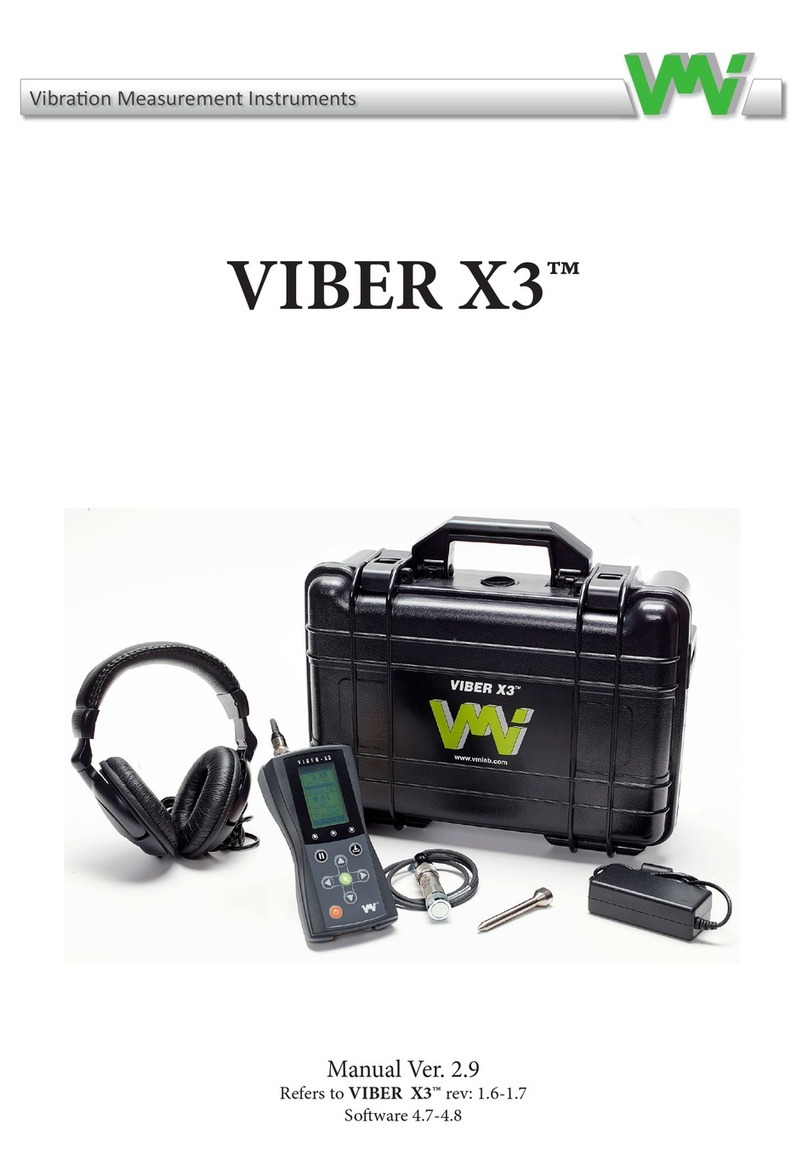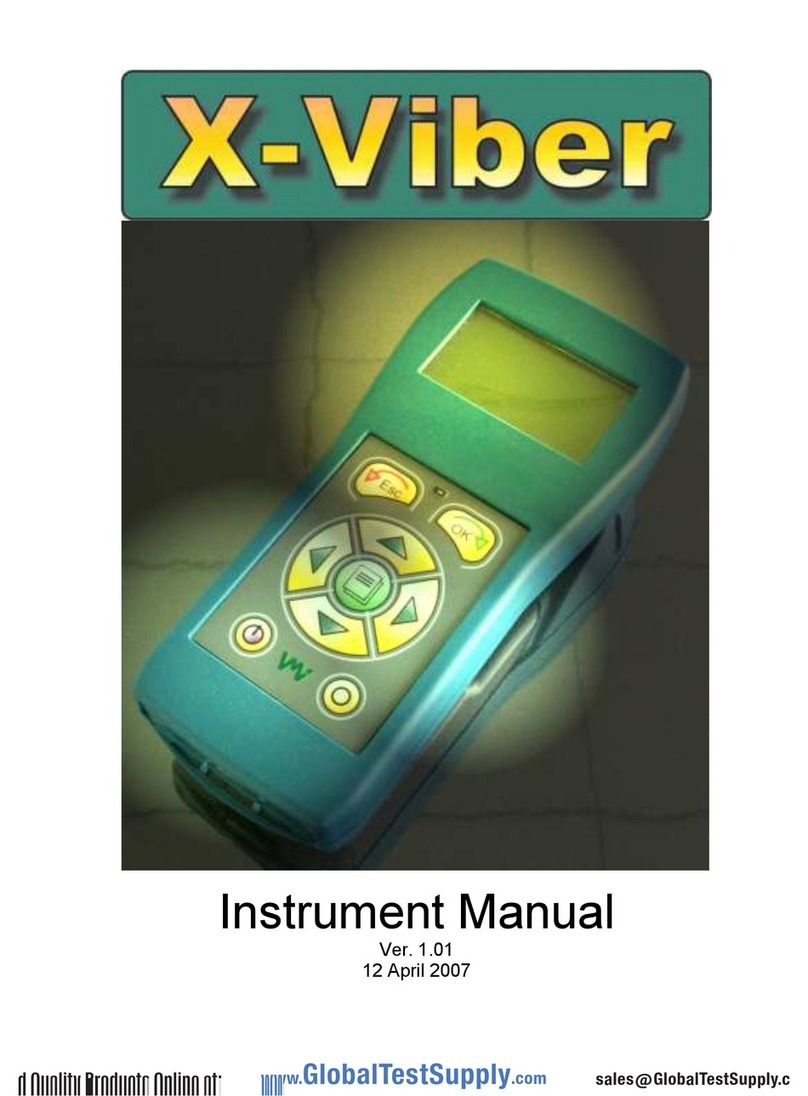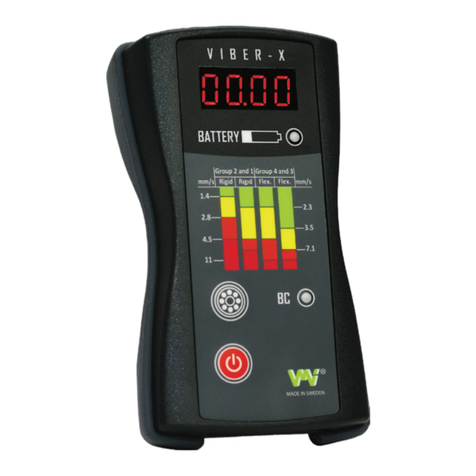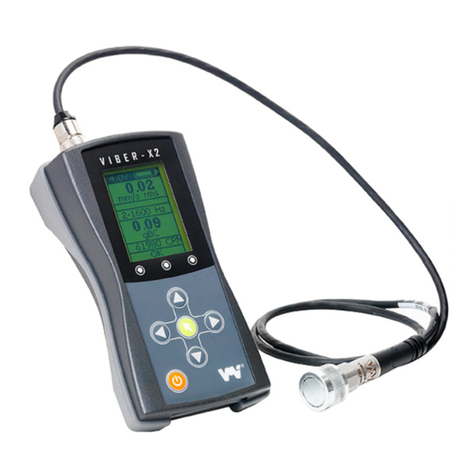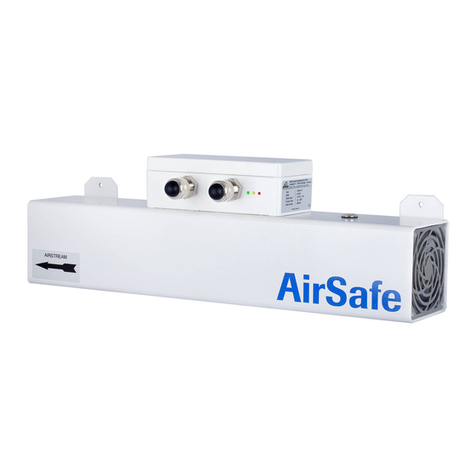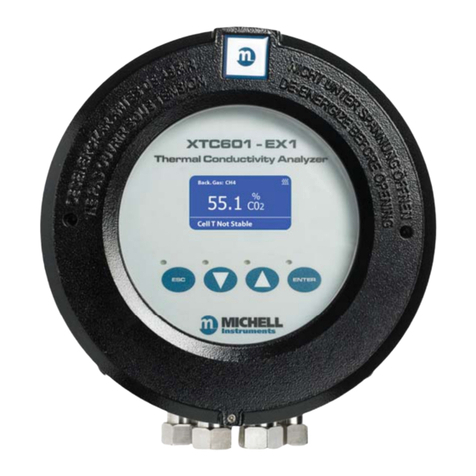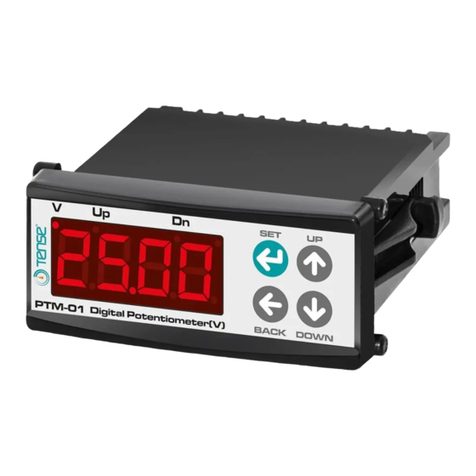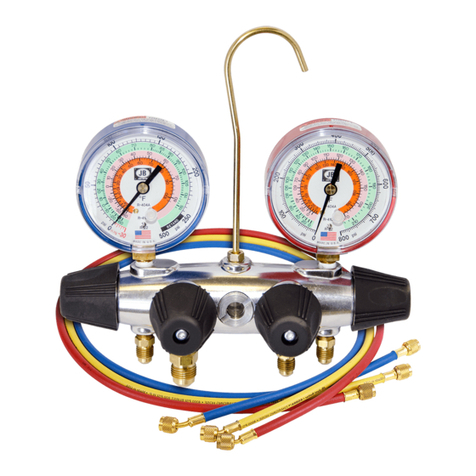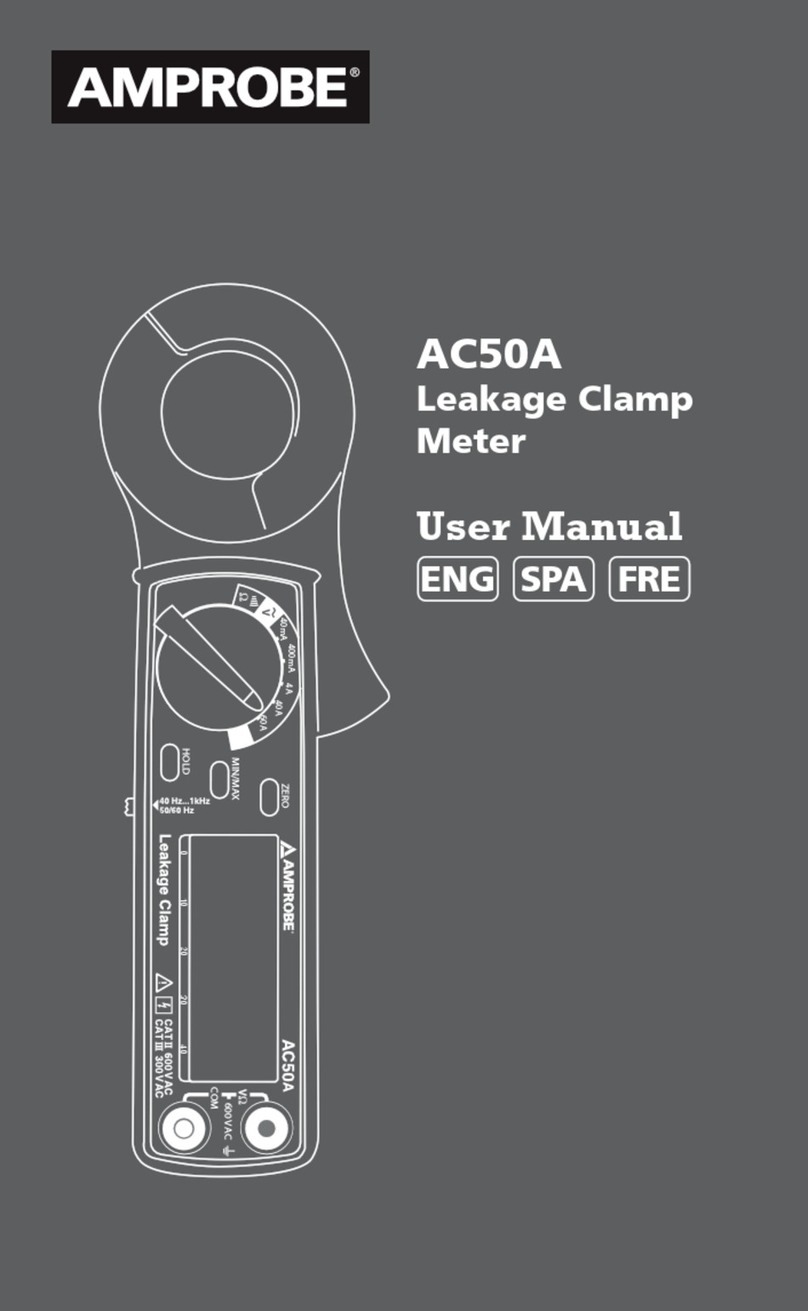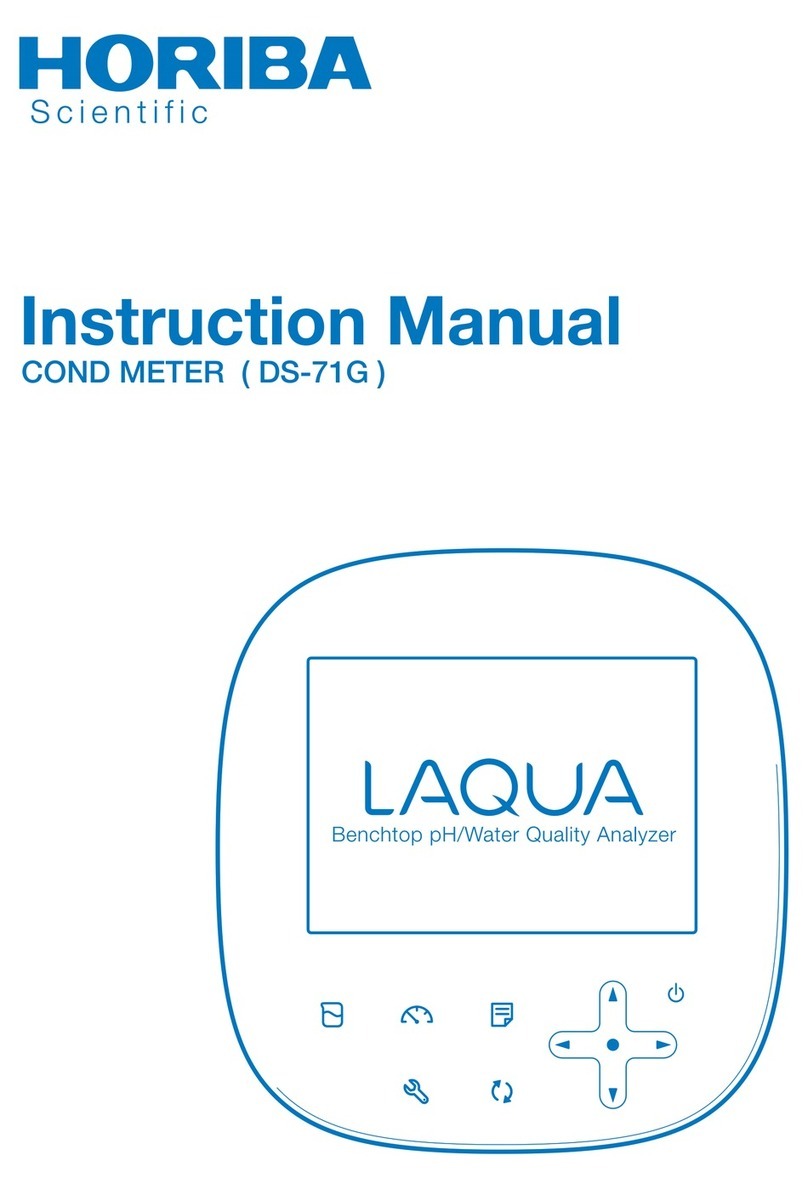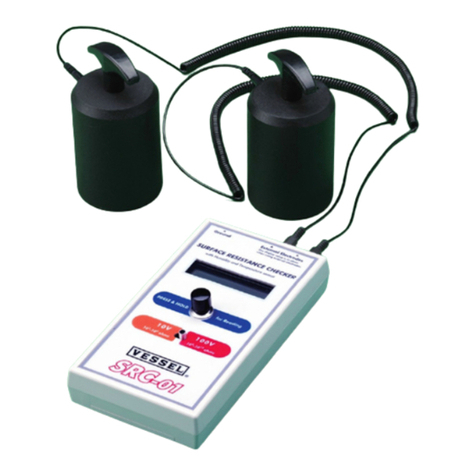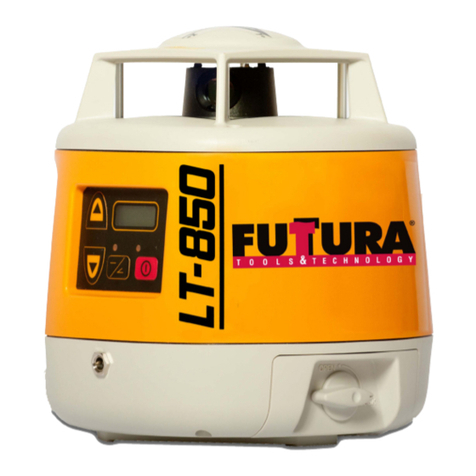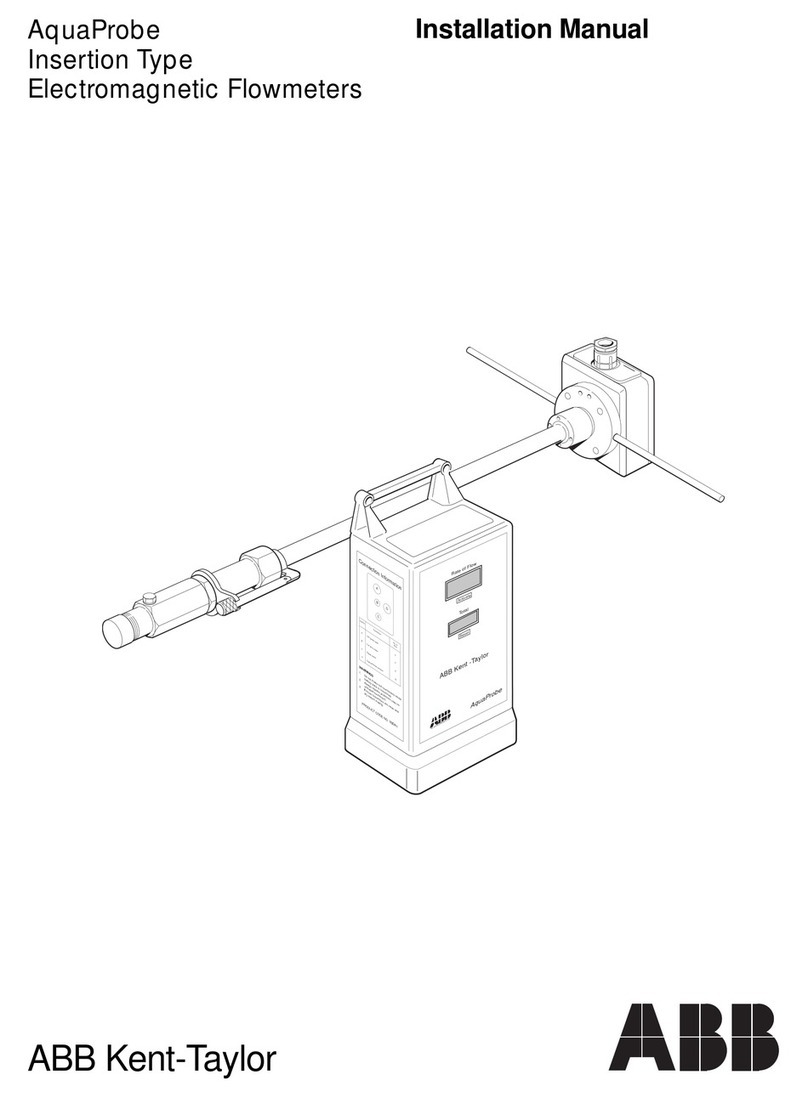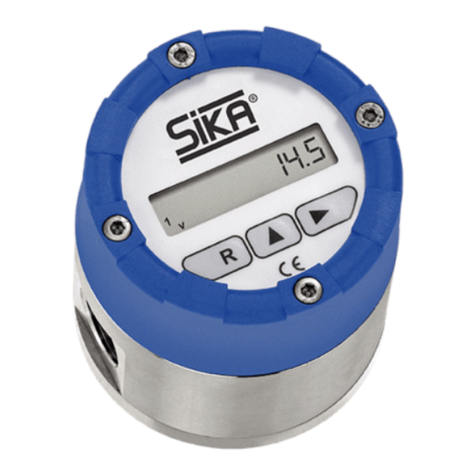VMI VIBER-A User manual

VMI AB
Torsgatan 1
S-603 63 Norrköping, Sweden
Tel. 011-311667 / 311668
Fax. 011-311678
e-mail: [email protected]
www.vmi-instrument.se
A
uthorised distribut
o
VIBER-A
Manual

Page 2

Page 3
Warranty disclaimer
VMI AB warrants the products to be free from defects in material and
workmanship under normal use and service within two years from
the date of purchase and which from our examination shall disclose
to our reasonable satisfaction to be defective.
Warranty claimed products shall be returned prepaid to VMI AB for
service. We reserve the right to repair or to replace defective
products.
Always try to explain the nature of any service problem. At best by
fax, e-mail or letter. Check first all natural problems, like empty
batteries, broken cables, etc. When returning the product, be sure to
indicate that the purpose is to make repairs and indicate the original
date of shipment to you if possible.
General
The VIBER-A is a fully portable broadband vibrometer used in
preventive as well as active maintenance work on rotating
machinery. A complete set comprises an instrument, a vibration
transducer with magnet support and an extension tip.
VIBER-A is measuring the effective velocity (mm/s RMS)
(displacement (µm Peak) or in/s is option) in the frequency range
between 10 and 3200 Hz. This range covers most of the frequencies
that will occur for the majority of mechanical malfunctions and
imperfections. Examples are unbalance, misalignment of shafts and
gears, cavitation and other fluid generated vibrations.
The judgement of the measured levels is greatly supported by
several vibration standards. The close comparison between vibration
levels and actual wear being performed on the machinery will quickly
build up a local knowledge. The experience should be used to
optimise the type of action required when higher vibrations are
found.
A common standard for judgement of vibrations is ISO 10816-3 and
may be available from your domestic standardisation authority. This
standard is an upgrade of older standards that has been in use for
several decades and has a world wide acceptance as a good
judgement for continuos and long lasting operation of machinery. It is
rare that this standard is found to be too restrictive so any reason to
judge vibration with a less exacting judgement should be well backed
by practical experience.

Page 4
Functions
Start of the instrument
Press this symbol key and the instrument starts to
measure.
The instrument will be shut off automatically after
approximately 2,5 minutes.
Battery check
Press this symbol key and keep it pressed and the
instrument shows the battery voltage.
Change the battery when the voltage is below 7 volts.
The battery capacity of an ordinary type is enough for
approximately 20 hours of constant operation or 350
measurement.
The battery capacity of an alkaline type is enough for
approximately 40 hours of constant operation or 1000
measurement.
Bearing condition
Press this symbol key and keep it pressed. The
instrument measures instantaneously a bearing condition
value in the range between 3.200Hz to 20.000Hz.
Placing of the measuring point.
The measurements should be taken on or as close to the bearing as
possible and only in horizontal, vertical and axial directions.
Bearing
Bearing
V
H H
V
A A

Page 5
How to make good measurements.
The sensitivity direction of the transducer coincides with the centre
axis of the transducer. The transducer end (with the M6 stud) is
pushed firmly against the measurement point. The main purpose is
to make the complete transducer to fully participate in the motion of
the measurement point. Try to hold the transducer in a vertical,
horizontal or axial direction as possible, even if the machine surface
does not have these directions. Read the instrument held with the
free hand. Note a stable reading as well as a fluctuating one, since
the fluctuation itself is a valuable information regarding the reason for
the vibration.
When the transducer is mounted with the magnet the frequency
range of the measurement is reduced to about 2.000 to 3.000Hz
depending on the flatness of the measuring surface.
When the measuring tip is used the frequency range is reduced to
about 800 to 1500Hz.
Note
When using the magnet or the measuring tip the bearing condition
value can be substantially changed. Use the M6 stud on the
transducer for high frequency measurements.
Vibrations at high frequencies can sometimes cause measurement
problems. Pressing the transducer more firmly should not change the
reading. If in doubt, always try to adjust the contact point first.
Secondly, if shown to be necessary, mount the transducer with the
M6 stud.
All normal measurements on vertical or horizontal machinery should
follow the three perpendicular axis of true vertical, horizontal and
axial directions. The reason is that you should keep to the main
stiffness directions caused by normal non symmetrical properties of
the foundation, piping, supports etc. It will result in better
understanding if the basic measurements are made in this way.

Page 6
The VIBER-A is mainly intended for measurements against the
housing and bearings of machinery according to the intentions
of the standards. You can also use it to measure other parts
such as piping, valves, etc. Note that in some cases the mass of
the transducer may influence the reading. A good rule is to
consider readings on surfaces that are lower in mass than 10
times the mass of the transducer doubtful.
How to interpret vibration measurements.
A user with no previous experience to interpret the results is
recommended to use the ISO 10816-3 standard together with a good
portion of common sense.
Be prepared to find exemptions making the judgements harder than
the standards, rather than finding exemptions allowing for higher
vibrations.
The standard normally calls for a measure in velocity based on mm/s
RMS. To better understand what this measure means it can be
helpful to consider the reading as a mean value of the back and
forward motion. This measure gives a good understanding of the
amount of "break down energy", causing mainly wear and fatigue
work, in the machine or the structure being measured.
The instrument is measuring the total RMS-value of the vibration
within the instrument frequency range. This RMS-value is a special
sum or average of all the different causes of vibration.
EXAMPLE:
If the simultaneous vibration caused by unbalance is (4mm/s), by
misalignment (2 mm/s) and by the gearmesh (5 mm/s) then the total
vibration measured on the VIBER-A is 6.7 mm/s.
Total vibration =

Page 7
The ISO standard is classifying the machines differently if the
machines are considered as flexible or rigid mounted. This reflects
the location of the machines stiff-body resonance’s related to the
basic running speed of the machine.
For instance, a machine supported by rubber or springs often have
resonance’s at low running speeds. The machine starts vibrate at
certain low rpm. When the speed is increased above these
resonance frequencies the vibration is reduced. This machine is
considered flexible.
A resonance can easily be found when a flexible machine is running
up or down in speed. The resonance’s are located at the rpm´s
where the vibration have a local maximum level.
Rigid Flexible Rigid Flexible
Group 1 and 3 Group 2 and 4
Industrial machines with power above 15kW and
nominal speeds between120 -15000 r/min
mm/s
Unit
0-1.4
1.4-2.3
2.3-2.8
2.8-3.5
3.5-4.5
4.5-7.1
7.1-11
11--
Extraction's from ISO 10816-3

Page 8
Modern machines have high rpm´s and flexible bearing-supports and
foundations and can be treated as flexible even when it is not
mounted on rubber or springs.
The ISO 10816-3 standard allows for slightly higher limits when a
foundation is considered flexible than when if it is rigid. A conclusion
from this is also that a resonant condition in principle is not allowed
or at least should be avoided at operating speeds. In practice this
also includes the double speed as well as any other natural
excitation frequency such as blade passage etc.
A great advantage with proper vibration measurements and the use
of vibration standards is that you can judge the future maintenance
cost very reliably already at first start-up. If you find levels above 3
mm/s RMS, you can be rather sure that the machine will cause
increased activities in maintenance. The specific cost and action is of
course individual to the machine design.
As always when using schematic judgement like this, be very careful
to use common sense in the application of the recommendations.
A certain machine is producing its specific vibration frequency
pattern depending on the transducer location and the machine
properties.
The next logical step is therefore to apply filtering of the transducer
signal to learn the frequency behind the vibration and thus the exact
mechanical fault. The practice of this is beyond the scope of this
manual.
Looseness
By measuring the vibration on both sides of a bolt joint it is possible
to find loosness in the connection. Two machine parts joined
together should have the same vibration level on both sides of the
joint.
Bolts fixed in concrete foundations should have the same vibration
level as the concrete if they are not loose.

Page 9
Recommended vibration levels in mm/s an common findings.
The following is in part an extraction of the old standard ISO 2372
class 4, large machines on flexible foundations, with some common
findings added.
This simplified list can be used, as a first consideration, when you
approach a machine newly commissioned or after some time in
operation.
Take as a good housekeeping rule to investigate the reason for any
machine that vibrates above 3 mm/s RMS. Do not leave them above
7mm/s without being assured that they will sustain long term
operation without increased wear since the machines capable of that
are very few.
•0 – 3 mm/s
Small vibrations. None or very small bearing wear. Rather low noise
level.
•3 – 7 mm/s
Noticeable vibration levels often concentrated to some specific part
as well as direction of the machine. Noticeable bearing wear. Seal
problems occur in pumps etc. Increased noise level. Try to
investigate the reason. Plan action during next regular stop. Keep
the machine under observation and measure at smaller time
intervals than before to detect a deterioration trend if any. Compare
vibrations to other operating variables.
•7 – 18 mm/s
Large vibrations. Bearings running hot. Bearing wear-out cause
frequent replacements. Seals wear out, leakage of all kinds evident.
Cracks in weldings and concrete foundations. Screws and bolts are
loosening. High noise level. Plan action soonest. Do your best to
reveal the reason. You are wearing down investments quickly.
•18 – mm/s
Very large vibrations and high noise levels. This is detrimental to the
safe operation of the machine. Stop operation if technically or
economically possible considering the plant stop cost. No known
machine will withstand this level without internal or external damage.
Reduce any further running time to an absolute minimum.

Page 10
Resonance
When working with vibrations in machine maintenance, you will soon
find that resonance is a common but rather unknown problem in
modern machinery.
To understand a resonance you can compare with the string of a
guitar. The string has its natural basic tune that will ring as soon as
the string is struck. The actual frequency of the tune depends on the
stiffness and the distributed mass of the string.
All machines have similar built in "tunes" with corresponding
properties consisting of stiffness and mass in the form of mechanical
strings such as shafts, beams, floors and in all mechanical parts.
If any natural excitation (= alternating force) in the machine has the
same or nearly the same frequency as a resonance frequency the
vibration will be amplified in this machine part, a much higher level
will occur than would be the case if the resonance would be shifted
away from the excitation frequency..
One common resonance frequency is the critical speed of a shaft
which depends on the stiffness and mass of the shaft, but
resonance’s exist in all machine parts as well as in supporting beams
and concrete floors.
A natural excitation force is for example unbalance at the running
speed, misalignment on mainly twice the speed etc.
THE BASIC RULE IS THAT THE RESONANCE’S OF ANY PART
IN THE MACHINE SHOULD NOT COINCIDE WITH ANY NATURAL
IMPULSE IN THE MACHINE.
A broad band vibrometer can not recognise the frequencies of
the vibration but as a rule most high vibrations are caused by
only one mechanical problem.

Page 11
To identify the presence of a resonance, measure the vibration levels
in three perpendicular directions at the bearings. If you find a
measurement with at least three times higher level than in the other
directions you should consider a resonance a likely possibility. The
resonance is amplifying the mechanical force and thus gives a high
vibration in that direction. The resonance makes the machine
unnecessarily sensitive to mechanical forces.
It is possible to locate the resonance peak while the speed of the
machine is changing. The resonance frequency is located at that rpm
where the vibration has a local maximum.
The proper action against a resonance is very different depending on
its location, operating conditions etc. It will normally require good
experience to alter the situation. One reason is that the modification
affects the basic mechanical design of the machine and where you
normally require the competence of the machine designer.
We recommend you however not to hesitate to consider such
modifications since the change of the resonance frequency normally
is cheap compared to the high maintenance cost that will follow any
attempt to run a machine in long term operation under the influence
of a resonance.
A TEMPORARY AND SOMETIMES PERMANENT SOLUTION TO
A RESONANCE PROBLEM IS TO CHANGE THE SHAFT SPEED
OF THE MACHINE, IF POSSIBLE.

Page 12
Press the green bearing symbol, keep it pressed and the instrument
measures the bearing condition value .
The bearing condition value is RMS value of all high frequency
vibrations in the range of 3.200 Hz to 20.000 Hz.
This average has the unit g(= acceleration due to gravity)
Bearing condition value with unit “g” RMS
The diagram above is only a guide to interpret the bearing condition
value. If vibrations of other causes (e.g. flow surge, gearmesh) are
within in the frequency range 3200 - 20000 Hz this can give a high
bearing condition value without the bearing being damaged.
A high bearing condition value can also be acquired if the bearing is
poorly lubricated or is overloaded (e.g. by misalignment, or belt
forces).
0,01
0,1
1
10
100
100 1000 10000
RPM
2000 3000400 60004000
500
Good
Acceptable
Fair
Failing
Replace

Page 13
What is a bearing condition value?
The bearing condition value in Viber-A is the sum average value,
RMS value, of all high frequency vibrations between 3200 Hz to
20000 Hz.
This value is an acceleration average with the unit "g" because high
frequencies give a large signal if it is measured in acceleration.
When the balls or rollers rotate inside the bearing a wide-band noise
and vibration arises. This noise and vibration are increased if the
bearing is poorly lubricated, overloaded due to misalignment or has a
damaged surface.
Because this is a wide-band noise and vibration it is possible to
select any frequency or frequency band as a measurement of
bearing condition.
If the selected frequency band includes low frequencies the bearing
condition value would also include vibrations from unbalances,
misalignment, etc., and not purely from bearing vibrations and would
therefor be difficult to interpret.
If the selected frequency band only includes very high frequency
noise and vibrations we would need special vibration transducers
that are very rigidly and closely mounted to the bearing because the
machine structure works as a mechanical filter for high frequencies.
VIBER-A is measuring the bearing condition value between 3200 Hz
to 20000 Hz, similar to many other instruments. Within this frequency
range there exist a common experience in the evaluation of the
bearing condition level.
Normal machinery vibrations such as unbalance, misalignment, etc.,
rarely has vibrations above 3200 Hz. The upper frequency limit of
20.000 Hz is selected because most vibration transducers have an
upper frequency limit of about 7000 Hz, without special mounting
arrangements, and the transducer signal is very low above 20000Hz.
NOTE!
A high bearing condition value should always be used as a request
to make frequency analysis.
High bearing condition values can appear at gear boxes, converting
machines with cutters and similar machines without any bearing
faults because they "naturally" produce frequencies above 3200 Hz.

Page 14
Balancing with VIBER-A
It is only possible to balance machines where the unbalance is the
major cause of vibration.
Do not change the position of the vibration transducer after the start
of the balancing procedure.
Balancing using this method requires only three consecutive trial
runs and changing the balance status of the rotor.
Only measurement of the vibration level is needed.
Balancing will of course only reduce the vibration caused by
unbalance.
A balancing round will often be a good approach and a first attempt
to find the reason for increased vibration. If the balancing attempt is
not successful, the cause can be loose rotor parts etc.
If the machine speed is variable, be sure to choose the same speed
during every trial run. Do not search the speed that gives the highest
vibration. Such speeds mostly show non-linear results.
Start the procedure by measuring on the bearings looking for high
levels in major directions. Choose a point that should have a good
connection to a balancing plane where you can put in a weight in the
machine. You must use the same radius for the trial weights and the
balancing weights.

Page 15
This is the procedure for the
TWO-POINT BALANCING METHOD:
TRIAL RUN 1:
Select the running speed and choose the measuring point. Measure
and note the vibration level and stop the machine. Note this vibration
as reading A.
TRIAL RUN 2:
Put in a trial weight in the balancing
plane. Note the location and size of the
balancing weight. Use its weight, volume
or length (if you have a band material) as
a measure of the size of the trial weight.
Call the trial weight P in any measure
proportional to the weight.
Measure and note the vibration level and
stop the machine.
Note this vibration as reading 2.
TRIAL RUN 3:
Move the trial weight 180 degrees to a
position opposite its first
location.
Measure and note the vibration level and
stop the machine.
Note this vibration as reading 3.

Page 16
CALCULATION
We now have all the necessary machine information to start the
calculations.
Compare the vibration levels reading 2 and reading 3.
Call the highest of reading 2 and reading 3 for Band the smallest
for C.
Draw a figure where you use a length measure proportional to the
actual vibration level measured on each reading A, Band C
respectively. Use a scale that gives you as large a figure as possible.
The accuracy depends largely on the size of the figure.
STEP 1: Draw Aas a horizontal line. Use a
scale so you achieve good use of the actual
paper.
STEP 2: Draw an arc centred at left end of
Ahaving the radius equal to 1/2 (HALF) the
length of B.
STEP 3: Draw an arc centred at right end
of Ahaving the radius equal to 1/2 (HALF)
the length of C. Mark the crossing of the
two arcs. Draw a line starting from the right
end of Athrough the crossing of the to arcs
and with the length proportional to C.
STEP 4: Join the upper tip of Cwith the left
end of Athat a triangle shaped figure is
made. Mark this new line as D. The angle
position of the balancing weight is the
angle (a) in the left corner of the figure
between line Dand base line A.

Page 17
THE SIZE OF THE BALANCING WEIGHT
The SIZE of the balancing weight that you should put on the
balancing plane is proportional to the size of the trial weight with the
same relation as the line Ato Din the figure. In other words:
trial weight P* the length of A
Balancing weight BW = ------------------------------------------
the length of D
You can measure Aand Din the figure. You may soon realise that
best results are obtained when the triangle has approximately equal
sides.
THE ANGLE POSITION OF THE BALANCING WEIGHT
When we had the trial weight in position C
we had a lower vibration than in position
B. The trial weight in position C must
therefore be on the proper half of the
rotor.
The balancing weight should be
positioned (a) degrees from the position
of the trial weight C.
The angle (a) can be measured on your rotor in either the direction
against or with rotation. You must make a qualified guess and try
one alternative. If the vibration is not reduced the other location may
be the better.
The balancing may be stopped when the highest radial direction is
below 3 mm/s rms.

Page 18
MISCELLANEOUS
If you prefer to calculate the balancing weight, this is the formula:
TROUBLE HINTS
The most difficult task in balancing is to guess a suitable size of the
trial weight because we do not know the unbalance sensitivity of the
machine. The whole balancing procedure depends on the changes in
vibration level that occur when we add a trial weight. If the trial
weight is too small compared to the unbalance we cannot measure
any changes in the vibration levels and the measurements A, Band
Cbecome almost equal. The triangle in our figure becomes flat.
If the trial weight is too large compared to the unbalance the
measurements Band Cbecome very large compared to the
measurement Aand the triangle in our figure becomes very high and
narrow.
This produces an uncertainty in our calculations.
If the triangle cannot be formed well, use the results to guess a
better trial weight size or try a location of the trial weight a quarter
turn away from the first position.
If the triangle cannot be formed at all there are often two major
reasons:
1. Something is loose. Check the fit between the rotor and
shaft. Check bolt joints. Is dirt gradually falling off during
each run?
2. The vibration does not depend on unbalance. You are trying
to balance a machine where the unbalance is very small and
where the vibration comes from other faults. E.g.
misalignment, gearbox, cavitation in pumps etc.

Page 19
BALANCING USING THE THREE-POINT METHOD.
The three point method gives you the size and the location angle (a)
without guessing the position of the balancing weight. Be sure to
choose the same speed during all trial runs and the same radius for
all trial weights and the balancing weight.
Step 1.
With the rotor operating at normal
speed, measure and note the original
vibration level as R1.
In our example: R1 = 8mm/s
Draw a circle with a radius proportional
to R1 and then use the same scale for
the rest of the procedure.
Step 2.
Stop the rotor. Mark three points on the
rotor, approximately 120 degrees apart
where we later will add trial weights.
Call these points A, Band C. These
three points do not need to be exactly
120 degrees apart but the accuracy
decreases the more you leave equal
spacing. You have to measure your
chosen angle position as accurate as
possible.
Step 3.
Put in a trial weight in position A. Start
the rotor and measure the vibration
level R2.
In our example R2 = 5mm/s. Draw a
circle proportional to R2 with the centre
in position A.

Page 20
Step 4.
Move the trial weight to position
B. Start the rotor and measure
the vibration level R3.
In our example R3 = 10mm/s.
Draw a circle proportional to R3
with the centre in position B.
Step 5.
Move the trial weight to
position C. Start the rotor
and measure the vibration
level R4.
In our example R4 =
12mm/s.
Draw a circle proportional to
R4 with the centre in
position C.
Table of contents
Other VMI Measuring Instrument manuals

